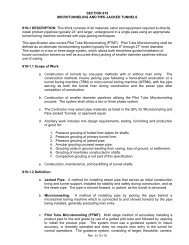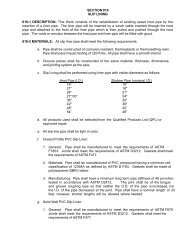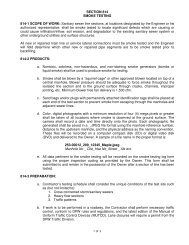Contents
Construction Management Plan - Baton Rouge Department of Public ...
Construction Management Plan - Baton Rouge Department of Public ...
- No tags were found...
Create successful ePaper yourself
Turn your PDF publications into a flip-book with our unique Google optimized e-Paper software.
2.2.2 Cement/Lime Dust<br />
(Reference CH2M HILL SOP HSE&Q-302, Concrete and Masonry)<br />
• Cement/lime dust may be corrosive to moist, damp skin.<br />
• The routes of entry are: skin contact, inhalation, eyes, ingestion.<br />
• Inhalation of cement/line dust may cause sore throat, coughing, choking and dyspnea.<br />
• Treat mild, acute skin contact with soap and water.<br />
• If clothing becomes saturated with wet cement/lime dust, it should be removed and replaced<br />
with clean, dry clothing.<br />
• Gauntlet style work gloves are required to be worn at all times at the site.<br />
• Wear impervious clothing (tyvek or cotton coveralls) with long sleeves and pants to eliminate<br />
skin contact. If walking or working in dry or wet cement kiln dust, wear impervious boots<br />
taped at the top of the pants let to keep dust or liquids from entering the boot.<br />
• Employees must have medical clearance and training in the proper use of respirators if the PEL<br />
and TLC are exceeded.<br />
• Immediately after working with cement kiln dust, workers should clean their skin thoroughly<br />
with soap and water.<br />
2.2.3 Chlorine<br />
(Reference CH2M HILL SOP HSE&Q-505, Chlorine Safety)<br />
CH2M HILL employees who work in proximity to chlorine-related operations must be aware of<br />
safe work practices and site-specific emergency procedures, and take all necessary precautions<br />
associated with avoiding and minimizing chlorine exposure.<br />
• Chlorine is used as a chlorinating and oxidizing agent, disinfectant, and in water and<br />
wastewater treatment. Its appearance is a greenish liquid or gas (it is a gas at normal<br />
temperature and pressure) with a characteristic, penetrating odor;<br />
• It is an irritant, highly corrosive and a strong oxidizer. It poses a hazard to the lungs, eyes and<br />
skin. It is toxic if inhaled, and it is harmful if swallowed. It causes respiratory tract, eye and<br />
skin burns. It can cause lung damage. In extreme cases difficulty in breathing may increase to<br />
the point where death can occur from respiratory collapse or lung failure. Liquid chlorine in<br />
contact with skin or eyes will cause chemical burns and/or frostbite;<br />
• NFPA Ratings: Health – 4; Flammability – 0; Reactivity – 0; Special Hazard Warning –<br />
OXIDIZER;<br />
• The threshold concentrations are (note there are 10,000 ppm in 1% of volume of air):<br />
• Odor 0.3 ppm;<br />
• Irritation 0.5 ppm;<br />
• TLV-8 hours 0.5 ppm;<br />
• PEL-C 1.0 ppm;<br />
• IDLH 10 ppm.<br />
• At the Baton Rouge WWTPs scrubbers are installed, and the chlorine alarms are set as follows:<br />
A-12 GNV310133632156.DOC/090840008












